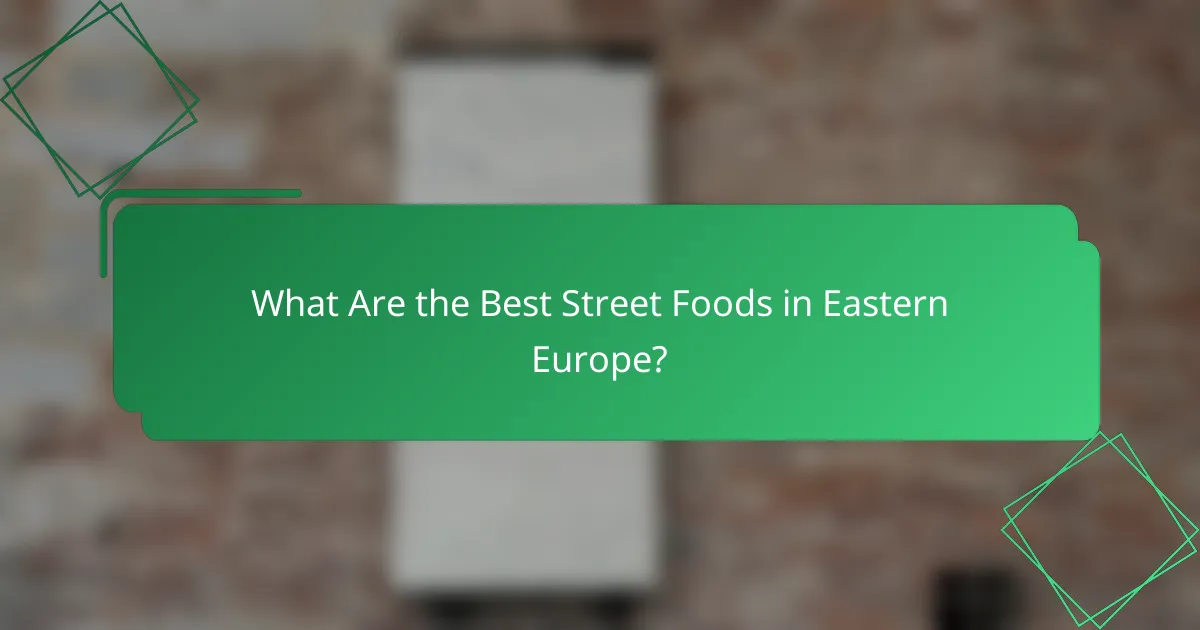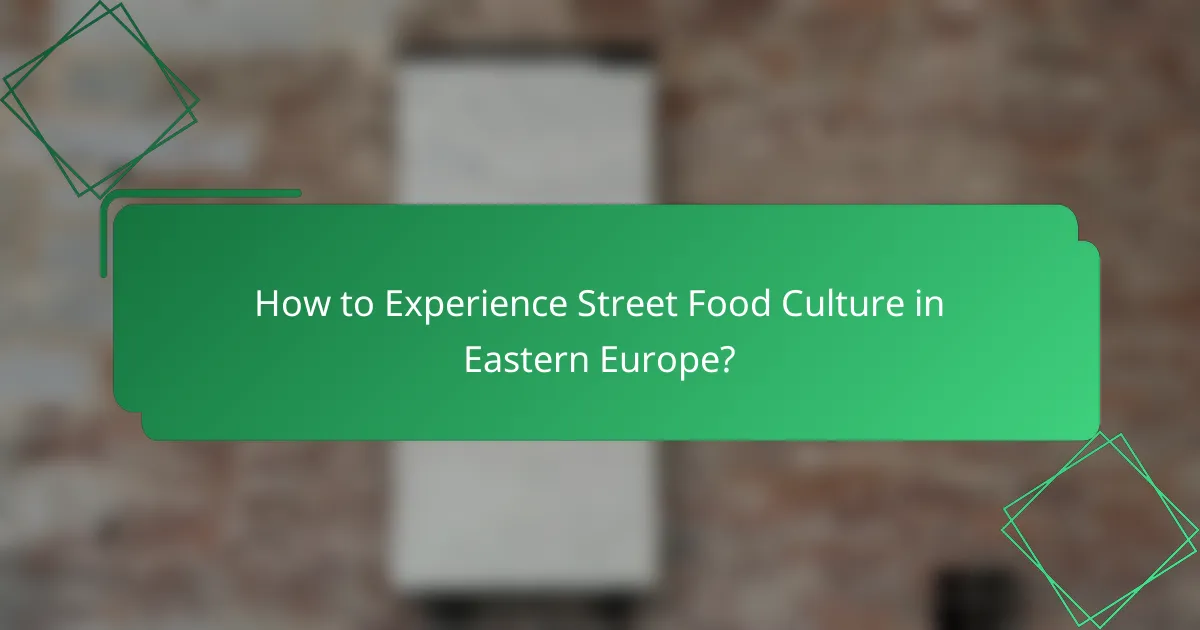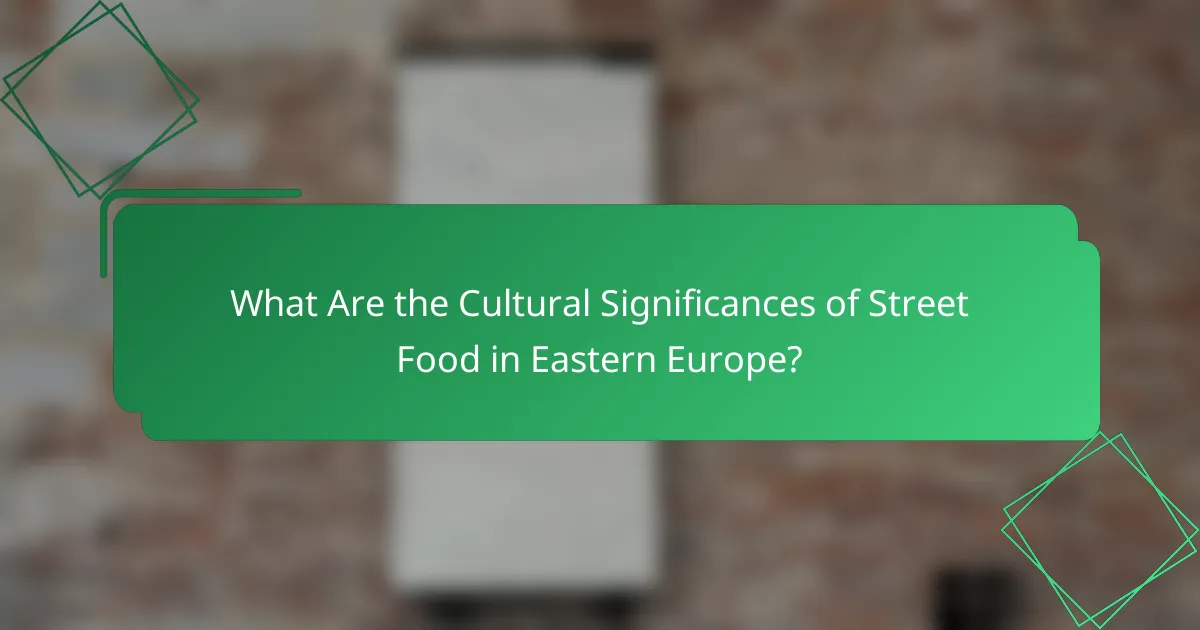Embark on a culinary journey through Eastern Europe, where street food showcases a vibrant tapestry of flavors and traditions. From savory pastries to sweet delights, each dish tells a story of the region’s rich cultural heritage. Dive into local markets, food tours, and festivals to savor the authentic tastes that define this unique gastronomic landscape.

What Are the Best Street Foods in Eastern Europe?
Eastern Europe offers a diverse array of street foods that reflect its rich cultural heritage and local ingredients. From savory pastries to hearty snacks, these dishes provide a unique taste of the region’s culinary traditions.
Burek in Bosnia and Herzegovina
Burek is a popular pastry in Bosnia and Herzegovina, made with thin layers of dough filled with meat, cheese, or vegetables. This flaky treat is often served hot and can be found at street stalls and bakeries throughout the country.
When enjoying burek, look for variations that include different fillings, such as spinach and cheese or pumpkin. Pair it with a side of yogurt for a refreshing contrast to the rich flavors.
Langos in Hungary
Langos is a deep-fried flatbread that is a staple of Hungarian street food. Typically topped with sour cream, cheese, or garlic, it is a deliciously indulgent snack that can be enjoyed at fairs and markets.
For a unique twist, try langos with sweet toppings like Nutella or fruit preserves. This dish is best enjoyed fresh and hot, straight from the fryer.
Pirozhki in Russia
Pirozhki are small, stuffed buns that are a beloved street food in Russia. They can be filled with a variety of ingredients, including meat, potatoes, cabbage, or sweet fillings like jam or fruit.
These portable snacks are perfect for on-the-go eating. Look for pirozhki that are baked or fried, depending on your preference for texture and flavor.
Zapiekanka in Poland
Zapiekanka is a Polish street food favorite, resembling a French bread pizza. Typically topped with mushrooms, cheese, and a drizzle of ketchup, it is a quick and satisfying meal.
For a more gourmet experience, seek out zapiekanka with additional toppings like ham or fresh herbs. This dish is often served at food stalls and is a popular late-night snack.
Kebab in Romania
Kebab in Romania is a flavorful dish made with marinated meat, usually grilled and served in pita or flatbread. It is often accompanied by fresh vegetables and sauces, making it a hearty option for street food lovers.
When ordering kebab, consider trying different types of meat, such as chicken, lamb, or pork, to find your favorite flavor profile. This dish is widely available at food trucks and stands across the country.

How to Experience Street Food Culture in Eastern Europe?
To fully experience street food culture in Eastern Europe, immerse yourself in local flavors by visiting markets, joining food tours, and attending festivals. These activities provide authentic insights into the culinary traditions and vibrant food scene of the region.
Visit Local Markets
Local markets are the heart of street food culture in Eastern Europe, offering a diverse array of fresh produce, meats, and ready-to-eat dishes. Markets like the Central Market in Sofia or Hala Mirowska in Warsaw are great places to sample local specialties such as banitsa or pierogi.
When visiting, look for stalls that have a steady flow of customers, as this often indicates quality and freshness. Don’t hesitate to ask vendors about their ingredients and cooking methods to deepen your understanding of the local cuisine.
Join Food Tours
Food tours are an excellent way to explore street food culture with the guidance of knowledgeable locals. These tours typically include visits to various eateries and markets, allowing you to taste a variety of dishes while learning about their history and significance.
Consider booking a tour that focuses on specific themes, such as traditional dishes or modern twists on classic recipes. This can enhance your experience and provide a deeper appreciation for the culinary diversity found in cities like Budapest or Prague.
Attend Food Festivals
Food festivals in Eastern Europe celebrate local cuisine and street food, offering a unique opportunity to taste a wide range of dishes in one location. Events like the Warsaw Food Festival or the Budapest Street Food Festival showcase both traditional and contemporary foods from various vendors.
Participating in these festivals allows you to engage with chefs and food artisans, providing insights into their culinary techniques. Be sure to check the festival schedules, as many events occur seasonally and can attract large crowds, so arriving early is advisable.

What Are the Unique Flavors of Eastern European Street Food?
Eastern European street food is characterized by its rich and diverse flavors, often influenced by local ingredients and cultural traditions. From hearty savory dishes to sweet treats, these flavors reflect the region’s history and culinary practices.
Spicy and Savory
Spicy and savory flavors dominate many Eastern European street foods, often featuring ingredients like paprika, garlic, and various herbs. Dishes such as spicy sausages or goulash are popular, offering a robust taste that warms the palate.
Common street food items include kebabs and pierogi filled with spiced meats or vegetables. When exploring these options, look for vendors who prepare their dishes fresh, as this enhances the flavor and authenticity.
Sweet and Sour
Sweet and sour combinations are prevalent in Eastern European desserts and snacks, often incorporating fruits like cherries, apples, and berries. Traditional sweets such as strudel or pączki showcase this balance, providing a delightful contrast to savory meals.
When trying these treats, consider sampling items that are locally made, as they often feature seasonal ingredients that elevate the flavor. Vendors may also offer unique twists on classic recipes, so don’t hesitate to ask about their specialties.
Smoky and Grilled
Smoky and grilled flavors are a hallmark of Eastern European street food, with many dishes cooked over open flames or in charcoal grills. Items like kebabs and smoked fish are commonly found, imparting a rich, deep flavor that enhances the overall experience.
Look for street vendors who specialize in grilled foods, as they often have a variety of options to choose from. Pairing these smoky dishes with traditional sides, such as pickled vegetables or fresh bread, can create a satisfying meal that highlights the region’s culinary heritage.

What Are the Cultural Significances of Street Food in Eastern Europe?
Street food in Eastern Europe holds deep cultural significance, reflecting local traditions, history, and social interactions. It serves as a culinary expression of regional identity, often showcasing unique flavors and ingredients that are integral to the local culture.
Historical Influences
The history of Eastern European street food is shaped by various cultural exchanges and migrations. Influences from the Ottoman Empire, Austro-Hungarian Empire, and Soviet Union have all contributed to the diverse culinary landscape. Traditional dishes like pierogi in Poland or khachapuri in Georgia highlight how historical events have molded local food practices.
Street food often incorporates seasonal ingredients and cooking methods passed down through generations. This connection to history not only preserves culinary traditions but also fosters a sense of community and belonging among locals.
Social Gatherings
Street food plays a vital role in social gatherings across Eastern Europe, serving as a focal point for community interaction. Markets, festivals, and fairs often feature food stalls that bring people together, creating a vibrant atmosphere. Sharing a meal from a street vendor can foster connections among friends and family, making it an essential part of social life.
Additionally, street food can be a gateway for tourists to engage with local culture. Visitors often seek out popular street food spots to experience authentic flavors and meet locals, enhancing cultural exchange.
Regional Variations
Each region in Eastern Europe boasts its own unique street food offerings, influenced by local ingredients and culinary traditions. For example, in Hungary, lángos (fried flatbread) is a popular street snack, while in the Czech Republic, trdelník (a sweet pastry) is widely enjoyed. These regional specialties reflect the diverse tastes and preferences across the area.
Understanding these variations can enhance the street food experience. Travelers should explore local markets and food festivals to discover the distinct flavors that each region has to offer, ensuring a richer cultural experience.

How to Choose the Best Street Food Vendors?
To select the best street food vendors, prioritize those with high customer traffic and positive reviews. Look for vendors who maintain cleanliness and offer a variety of fresh, appealing options.
Look for Crowds
Crowds are a strong indicator of a vendor’s popularity and food quality. If a stall has a long line, it often means the food is both tasty and safe to eat, as many customers are willing to wait for a good meal.
Observe the crowd’s demographics as well. A diverse group of locals usually signifies that the food is authentic and well-regarded. In contrast, if only tourists are present, the vendor may cater more to visitors than to local tastes.
Consider the time of day when assessing crowds. Busy lunch spots may slow down in the evening, while dinner vendors might peak later. Timing your visit can enhance your chances of enjoying freshly prepared dishes.
